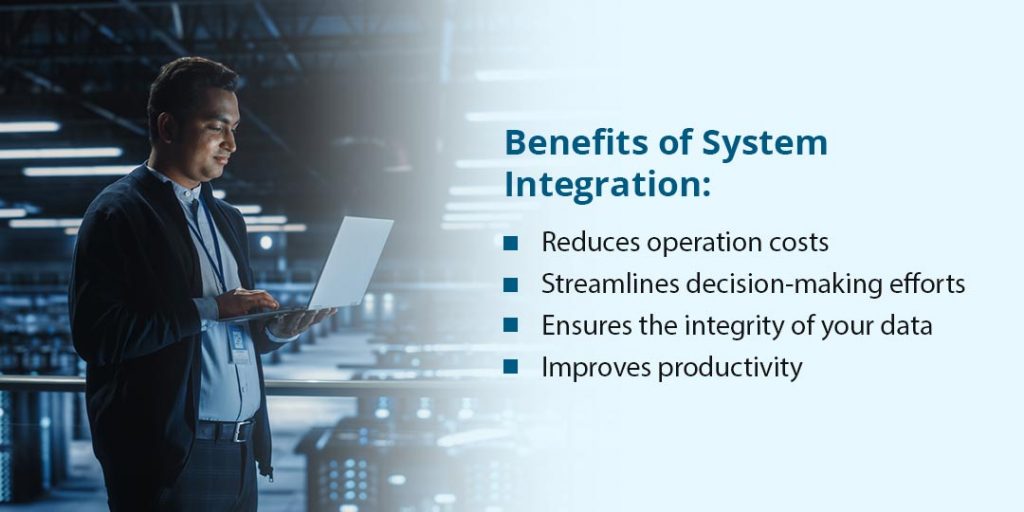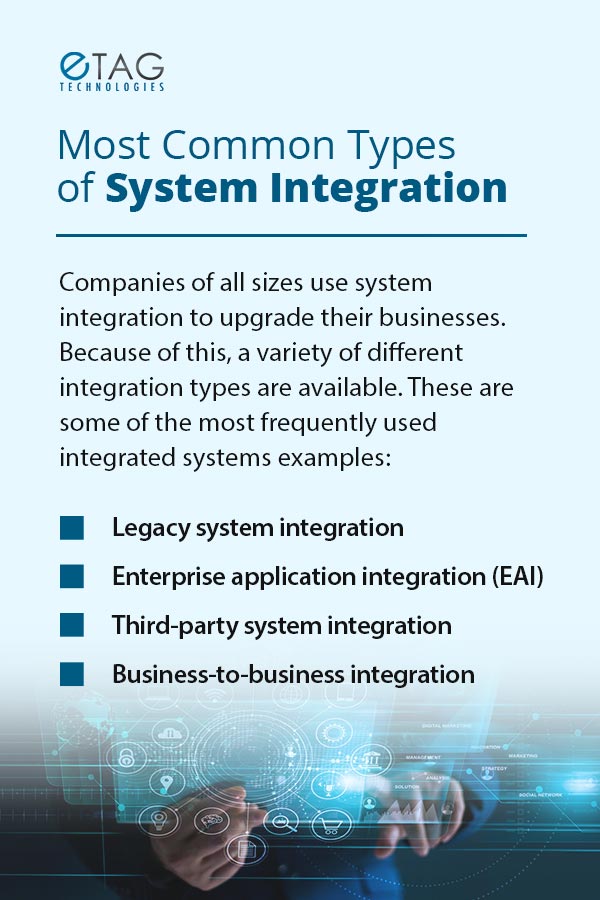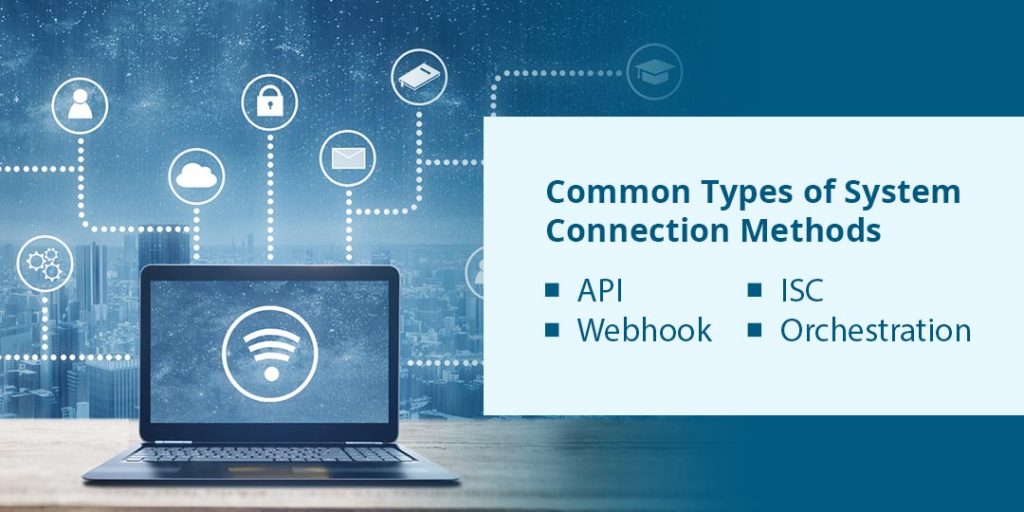System Integration Methods


Companies use a wide variety of methods to house critical data. With so many IT services and capabilities available, inputting information in different systems becomes simple. Businesses might use various forms of software and hardware to keep operations running smoothly.
However, using too many methods can become challenging over time. You might be unable to share information or communicate across all platforms, leading to disjointed data and inefficient processes. System integration lets you combine software and hardware into a comprehensive system, and different system integration methods can streamline your entire data and communication processes.
Read on for more information on systems integration.
What Is System Integration?
System integration is the practice of combining individual subsystems into a single, comprehensive unit. For companies, this often refers to linking different IT systems and software into one. Once combined, they work together smoothly and improve business efficiency.
Software system integration can connect businesses to important third parties, such as shareholders. You can access crucial business information in one location and speed up communication between you and other officials.
What Is a System Integrator?
Navigating the integration process can be challenging if you’ve never tried it before. Many companies hire system integrators to design and implement their system integration plan. A system integrator can be either an individual or an organization specializing in integrating systems for companies. After analyzing your current setup, logistics and resources, they create a plan for seamless integration.
Hiring a systems integrator has many benefits. They can test and maintain your technological operations, ensuring your systems are combined successfully. Their expertise and connections with fellow vendors allow you to combine your software easily.

How Do Systems Integrations Benefit Organizations?
Businesses that implement a system integration strategy will experience many advantages. From improved work quality to lowered technology costs, companies can enjoy benefits in all aspects of their operations.
Here are more benefits of system integration:
- Reduces operation costs: Systems integration lets you center all of your organization’s software and applications in one location. You don’t have to pay separate handling or subscription costs for each separate application because they’re all streamlined into one. This also means your company can save on maintenance fees. Instead of managing maintenance needs and costs for each application, you only navigate one for all of your software systems. For example, when it’s time to update your software and hardware, you will only have to update a single combined system rather than each unit.
- Streamlines decision-making efforts: Acomplete system integration also assists with the decision-making process. You can access all of your company’s crucial data in one location, making it easier to identify data trends. Whenever you need to analyze new data or contact a coworker, an integrated system lets you complete these tasks easily. With all of your company data readily accessible, you can make holistic decisions in just moments.
- Ensures the integrity of your data: More and more companies are turning to digital headquarters, where they centralize their programming online and expand with employees around the world. For these businesses and all others relying heavily on online systems, accurate data is crucial. Integrated systems update your data on all systems simultaneously. As soon as something changes, all pages instantly update with the new information. The more updated your data is, the more accurate it is. All of your company’s departments can stay on the same page, increasing efficiency in your workplace.
- Improves productivity: With an integrated system, you have centralized control over all data processes. Many systems operate on automatic data transfers, reducing the risk of human error. Instead of spending time manually sending data or working through different hardware, you can focus on other crucial job aspects. Business functions like contacting vendors, communicating with shareholders and fulfilling customer orders are all streamlined. In turn, your business can work more efficiently and decrease turnaround times.
Overall, a systems integration can help your company achieve higher efficiency rates, improve communication and much more. Those looking to streamline processes and boost productivity rates should consider this solution.
Challenges Systems Integrations Faces
When considering the pros and cons of system integration, many positives are available for companies. However, you might also face some challenges with system integration, such as:
- Security risks: Putting all of your company’s digital records into one place is an extensive process. Because all of your information is in a single location, it could be easier for a hacker to access it with one security breach. When you store your data in separate components, it’s typically more difficult for attackers to access it all at once. Your company should have intensive security measures to ensure everything stays protected. Fortunately, many digital security systems are available to protect your company’s data.
- Complicated process: System integration can be a complicated process, especially without skilled team members. To combine all the applications, you have to upgrade them individually first. A systems integrator guides the development, but you often need other IT professionals to transfer each software type. This process can take weeks or even months, so if your business doesn’t have that time or expertise available, it could be difficult to fit into your schedule.
- Investment expenses: System integration is a worthwhile investment, but it can be initially costly. You have to invest in each program and its upgrade. Depending on how many different systems your company uses, these costs can add up. Some businesses unprepared for these initial expenses might be deterred from system integration.
Despite these considerations, system integration is valuable for businesses for many reasons. Although it costs extra initially, the reduced costs over time outweigh these expenses. Many companies find streamlined processes lead to higher efficiency overall, making these first challenges worth it. It’s ultimately up to your company to decide what is best for you.

Most Common Types of System Integration
Companies of all sizes use system integration to upgrade their businesses. Because of this, a variety of different integration types are available. Companies can find the integration plan that suits them most closely and begin the integration process from there.
These are some of the most frequently used integrated systems examples:
- Legacy system integration: Legacy systems integration focuses on outdated software. Your company might use older hardware or software that isn’t as fast as modern versions. Many businesses have used outdated applications for so long that they fear upgrading due to a potential data loss. Other businesses might be unable to upgrade these systems because they are central to core business functions. The goal of legacy system integration is to modernize outdated applications. You can integrate outdated systems with newer ones by opening communication channels and technology solutions. This integration type lets you update and connect your system without losing them.
- Enterprise application integration (EAI): Enterprise application integration focuses on unifying subsystems into one centralized ecosystem. The process links all important business functions, from accounting software to financial transactions. An enterprise application integration combines all of these systems into one, allowing for real-time data updates and communications. Once the systems link, they can automatically exchange updates and information, unifying applications. Many enterprise integration systems are automatic, meaning your digital records constantly update without any manual work from you. Companies use this system type to streamline business processes.
- Third-party system integration: Third-party integration is another system integration example. This type lets you connect existing applications with other software to broaden the functionality of your current systems by connecting them with more advanced features. For example, you could add an online payment system to one of your business applications. This is a popular integration type because it lets businesses enjoy updated features without investing in new, customized software. Working with your system integrator, you can choose from a variety of third-party apps to expand your business capabilities.
- Business-to-business integration: Business-to-business integrations link companies together. With so many businesses working together for trade and supply, it’s beneficial to have a centralized system. These integrated systems enhance cooperation between businesses, making communication easier. For instance, if a purchaser and a supplier integrated their web systems, they could easily access updates about supply chain inventory or order requests. In turn, business transactions are smoother and more informative between parties.
No matter what integration type you choose, they all create cohesive networks. With all of your data in one place, you can access it easily and put more time into other business functions.

Common Types of System Connection Methods
There are multiple different ways you can connect separate systems. These are some of the most common methods.
API
Application Programming Interface (API) is the most commonly used form of system integration. They provide a straightforward way to connect two systems — by being placed between applications and web systems, they facilitate data transmittance. You can implement these systems by using common code language to equalize them.
API has many advantages, like:
- High accessibility: As the most common integration method, API is available for most programs. No matter what system type your business uses, you could implement API into your integration project.
- Versatility: API can manage most code variations, making it a versatile option across all software types.
- Increased efficiency: Once your software systems connect, you can easily access all applications. Your systems link together without disrupting ongoing operations or third-party applications.
However, they also feature a few cons:
- Code-dependent: APIs are based on programming codes. While this is highly useful, programming each code can be time-consuming and complicated without expertise.
- Supplier necessity: Suppliers must first establish an API. This limits the scheduling and capability of other parties, which sometimes complicates the process.
Webhooks
Webhooks are another type of systems integrations method. Instead of using codes to link systems, webhooks use real-time messaging to connect applications. Designers place programming modules inside each application, and they’re triggered whenever a significant change occurs. Management or other leading professionals receive alerts when changes occur in the system.
For example, you could link your accounting software and online payment gateways such as PayPal. Whenever a transaction occurs, a webhook could alert leading officials or whoever else necessary.
Here are some advantages of webhooks:
- Instantaneous data: As soon as a change is made, webhooks notify leading officials immediately. This rapidity gives officials access to the updated information in real-time.
- Automatic updates: You don’t have to manually look for updates with webhooks. Instead, notifications come directly to you and constantly update with new information.
There are also some disadvantages to webhooks, like:
- Limited notifications: Webhooks need to recognize a specific event to be triggered. If you wanted to be alerted of more subtle instances, you might not be able to find a webhook to accommodate this.
ISC
Integration service components (ISC) are an additional method for system integration. These components are based within a server and link with management tools. In turn, they make it easier to access files or upload large new files.
One of the most significant benefits of ISC is its functionality. As long as you have cloud services within your web services, you can connect to ISC.
But this method also has some negatives, such as:
- Expertise needed: To set up an ISC, you need extensive knowledge of local databases and servers.
- Complete access to applications needed: You also require full access to applications, even back-end developments. Many businesses don’t have these capabilities, making it challenging to implement an ISC.
Orchestration
Finally, orchestration is another integration type. Orchestration consolidates many business processes to improve efficiency. It combines automation techniques with an enhanced user experience. Implementing orchestration can also help your company transform into a digital environment altogether.
Orchestration has many benefits, like:
- Improved productivity: Orchestration combines all crucial work databases and often makes them simpler to navigate. With all of your important data in one access point, your team can work more efficiently.
- Enhanced accessibility: You can also give employees access to business applications with this method. The increased accessibility might make encourage more engagement in your workplace.
However, there are also some drawbacks:
- Intense work required: Orchestration is often a long and complicated process, which could be frustrating for companies without adequate preparation.
- Code-intensive: Orchestration also requires coding to develop fully, which could be a lengthy process without the right knowledge.
Streamline Your Organization’s Integration Process With eTag Fuse®
eTag Fuse® provides a variety of digital integration solutions for companies across the country. Our integration software helps you optimize business functions and reduce excess costs by connecting all your applications into one place. With an integration platform, you can implement automatic business functions, share data across applications, streamline procedures and more.
No matter the size of your organization, you can link departments and boost efficiency. With all of your data housed in a single location, you can increase engagement and enhance your workplace culture. Elevate your digital methods with an integration method today.

Contact eTag Fuse® Today
The importance of system integration cannot be understated. From lowering annual costs to streamlining business procedures, an integration strategy is necessary to take your business to the next level.
If you’re looking for a systems integration solution, consider eTag Fuse®. Our high-quality integration solutions can help you digitally transform productivity and accessibility across your work fronts. We can help you find the digital solutions you need, no matter your business. To get started with eTag Fuse®, request a demo today.

















